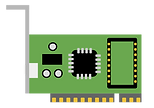3.2b: Protocols & Layers
Exam Board:
OCR
Specification:
J277
Watch on YouTube:
IP & MAC Addresses
Protocols & Standards
Common Protocols
Protocol Layers
Protocols
A protocol is a set of rules that allow devices on a network to communicate with each other.
TCP / IP
(Transmission Control Protocol / Internet Protocol)
TCP / IP is actually two separate protocols that combine together.
TCP is a protocol that allows packets to be sent and received between computer systems.
It breaks the data into packets and reorders them back into the original data at the destination.

IP is a protocol in charge of routing and addressing data packets. This ensures data packets are sent across networks to the correct destination.
It is also an addressing system - every device on a network is given a unique IP address so data packets can be sent to the correct computer system.
HTTP is used to transfer web pages over the Internet so that users can view them in a web browser.
All URLs start with either HTTP or HTTPS
(e.g. https://www.csnewbs.com).
HTTPS is a more secure version of HTTP that works with another protocol called SSL (Secure Sockets Layer) to transfer encrypted data.
You should see a padlock symbol in the URL bar if your connection to that website is secure.
HTTP/HTTPS
(Hypertext Transfer Protocol)
Transfer Protocols
FTP (File Transfer Protocol) is used to transfer files across a network. It is commonly used to upload or download files to/from a web server.

SMTP (Simple Mail Transfer Protocol) is a protocol used to send emails to a mail server and between mail servers.

POP (Post Office Protocol) and IMAP (Internet Message Access Protocol) are both protocols for receiving and storing emails from a mail server.

POP will delete an email from the email server once it has been downloaded to a device.
Pop!

IMAP syncs the message with an email server so it can be accessed by different devices.

IP Address & MAC Address
There are two versions of IP addressing currently used - IPv4 and IPv6.
IPv4 is a 32-bit address, represented in denary, that allows for over 4 billion unique addresses.
It has four 8-bit segments of denary values (from 0 to 255) separated by full stops.
IPv4 example:
145.13.218.102
IPv6 is a 128-bit address, represented in hexadecimal, that allows for an undecillion unique addresses.
It has eight 16-bit segments of four hexadecimal values (0000 - FFFF), separated by colons.
IPv6 example:
736E:1029:A4B3:902D:77B2:72FF:AE62:0912
A MAC address is a unique hexadecimal number assigned to each network interface card/controller inside a networked device such as a router or laptop.
A MAC address is a 48-bit address made up of six 8-bit pairs in hexadecimal, separated by dashes.
While an IP address may change, the MAC address can’t be changed. MAC stands for Media Access Control.

Network Interface Card (NIC)
MAC example: 19-C2-D1-47-AA-38
Networking Standards
Networking standards are rules that allow computer systems to communicate across networks. Standards have been created to ensure devices can exchange data and work together by interpreting signals in the same way, regardless of the manufacturer.
TCP/IP Stack & Layers
What is TCP/IP?
TCP/IP (Transmission Control Protocol / Internet Protocol) is a set of protocols that operate on different layers. These two protocols are used together to allow computers to communicate on a network.
What is a protocol layer?
A layer is a division of network functionality - each layer provides a specific function to assist the transmission of the data that is being sent. TCP/IP is split into four layers (named Application, Transport, Internet and Link).
Important Note: You do not need to know any layer names or the purpose of any specific layers in the OCR GCSE J277 specification, just what layers are and why they’re used.
Why are protocol layers used?
-
Layers are self-contained, so they allow different developers to concentrate on one aspect of the network at a time. A layer can be taken out and edited without affecting other layers.
-
Protocol layers are used to visualise the different parts of a network, as each of the four layers of TCP/IP has a specific role and is associated with different protocols.
-
Protocols are broken down into well-defined, specific layers to simplify design, making it easier to identify errors (known as troubleshooting).
-
Each layer uses specific protocols, so layering ensures these protocols are applied in a specific order. This process uses abstraction and layers only communicate with adjacent layers for easy compatibility.

Questo's Questions
3.2b - Protocols & Layers:
1. Describe each of the following protocols. It might be helpful to also draw an icon or small diagram for each one:
-
a. TCP [2]
-
b. IP [2]
-
c. HTTP & HTTPS [3]
-
d. FTP [2]
-
e. SMTP [2]
-
f. POP3 & IMAP [2]
2. State which protocol would be used in the following scenarios:
-
a. Transferring a music file to a friend over the internet. [1]
-
b. Sending an email to a family member in America. [1]
-
c. Using a webpage to enter a password securely. [1]
-
d. Receiving an email from a bank. [1]
3a. What are networking standards? [2]
3b. What is TCP/IP? [2]
3c. What is a protocol layer? [2]
3d. Give at least two reasons why protocols are split into layers. [4]